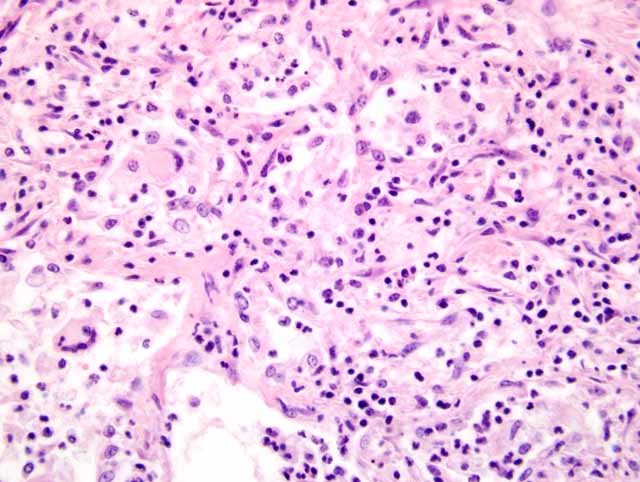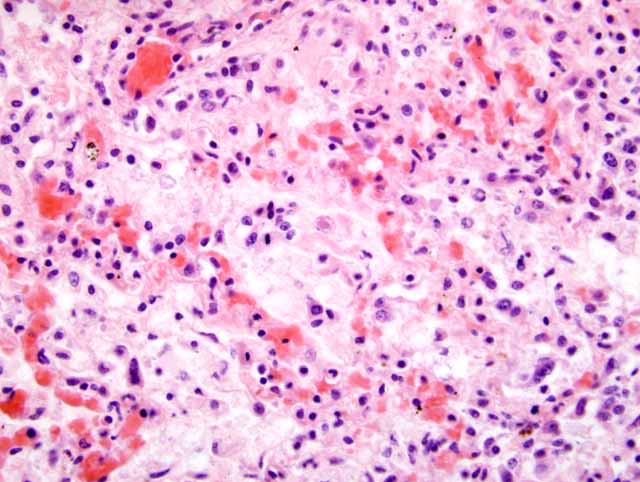Signalment:
Gross Description:
Histopathologic Description:
Morphologic Diagnosis:
Etiology: Equine Herpesvirus-5 (EHV-5)
Condition:
Contributor Comment:
EMPF is most common in middle-aged horses. Horses with this disease present with non-specific signs of respiratory disease including cough, fever, weight loss, tachypnea, increased respiratory effort, and nasal discharge. Treatment with antibiotics may result in short-term improvement, but symptoms recur after treatment is discontinued. Pulmonary nodules can be visualized with ultrasonography and/or radiography. Rule outs include neoplasia, fungal pneumonia, and granulomatous pneumonia, which may also result in a nodular pattern. Treatment of choice includes long-term (at least 6 weeks) administration of corticosteroids. Prognosis for the disease is considered fair to poor. Many horses are euthanized due to continued respiratory complications and poor athletic performance.
Lung tissue from this horse was positive via polymerase chain reaction (PCR) for EHV-5. EHV-5 is a DNA gammaherpes virus that has only recently been associated with this disease entity. The pathogenesis of EHV-5 in this disease has not been fully elucidated but may contribute to a pro-fibrotic lung environment via a Th-2 lymphocyte inflammatory response. PCR can be performed on bronchoalveolar lavage samples or lung tissue. Unlike EHV-2, another common viral cause of equine respiratory disease, EHV-5 is not isolated from healthy horses or horses with respiratory disease due to other etiologies. A study by Bell identified EHV-5 in 64% of young racehorse nasal swabs, while a study performed by Wang identified the virus in 48% of 5-9 month old Thoroughbred foals.Â
Intranuclear inclusion bodies are not a common feature in gammaherpes infections but may be observed in California sea lions infected with genital carcinoma caused by gammaherpes virus. Murine herpesvirus-68 is a gamma herpesvirus associated with experimental fibrotic lung disease in mice.
JPC Diagnosis:
Conference Comment:
| Alpha herpesvirus | Disease |
| Equine herpesvirus 1 | Abortion, foal mortality, neurologic and respiratory disease |
| Equine herpesvirus 3 | Coital exanthema |
| Equine herpesvirus 4 | Rhinopneumonitis |
| Bovine herpesvirus 1 | Infectious bovine rhinotracheitis, infectious pustular vulvovaginitis |
| Bovine herpesvirus 2 | Bovine mammilitis, pseudo-lumpyskin disease |
| Porcine herpesvirus 1 (pseudorabies; Aujeszky's Disease) | Abortion in adults and generalized disease in younger animals; death in other species |
| Canine herpesvirus 1 | Pneumonia, hepatitis, nephritis hemorrhagic disease |
| Feline herpesvirus 1 | Feline viral rhinotracheitis |
| Gallid herpesvirus 1 (chickens) | Infectious laryngotracheitis |
| Gallid herpesvirus 2 (chickens) | Mareks disease |
| Anatid herpesvirus 1 | Duck plague |
| Cercopithecine herpesvirus 1 (B virus) | Herpes simplex-like disease in macaques; encephalitis and death in humans |
(1) |
References:
2. Williams KJ, Maes R, Del Piero F, Lim A, Wise A, Bolin DC, Caswell J, Jackson C, Robinson NE, Derksen F, Scott MA, Uhal BD, Li X, Youssef SA, Bolin SR: Equine multinodular pulmonary fibrosis: a newly recognized herpesvirus-associated fibrotic lung disease. Vet Pathol 44(6):849-62, 2007
3. Wong DM, Belgrave RL, Williams KJ, Del Piero F, Alcott CJ, Bolin SR, Marr CM, Nolen-Walston R, Myers RK, Wilkins PA: Multinodular pulmonary fibrosis in five horses. J Am Vet Med Assoc 15:898-905, 2008

